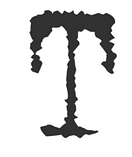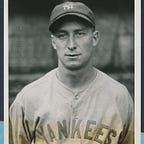Thursday, May 19, 1927: Cleveland
Bonesetter Reese
5:00 a.m.
That’s what time this morning my roommate, Benny Bengough, Lou Gehrig, and I set out for Youngstown, Ohio, a three-hour drive from the Hollenden House hotel here in Cleveland.
Youngstown is where Benny will finally be examined by “Bonesetter” Reese — and where the three of us will find out if the Bonesetter’s renowned powers of healing can save Benny’s career.
Our 5:00 a.m. departure is necessary because we have a game against the Indians this afternoon at 3:30, and Cleveland to Youngstown is a five-and-a-half-hour round trip. My guess is it will be closer to six, the way Gehrig drives.
Benny is a terrific catcher, or rather would be, if his arm wasn’t useless for nine months out of the year. Benny can barely get the ball to second base until the weather gets warm around late June — it’s just too painful for him to throw, and even without the pain, his arm just doesn’t have any strength until the days warm up. In July, August, September and early October, Benny throws just fine. The rest of the year? Hell, if you wanted to steal second base off Benny in April, May or early June, you could walk the 90 feet.
During spring training Miller Huggins, told Benny not to worry, that he’d be coming North with the club to work with the pitchers until his arm got loose again in June. Benny was appreciative of the chance to stay with the squad, but he is worried — desperately worried — that his arm might never come back.
 There are few things as desperate as a ballplayer fearing he’s losing his grip on the game. You see it every season in the eyes of the older players, as they look around the locker room and can’t help but notice that their hair is thinner, their stomachs are thicker, and their muscles are less defined than their younger counterparts. Eventually all older ballplayers come to the realization that no amount of experience, no amount of knowledge of the game or guile is going to keep them in the major leagues much longer. And at that moment, for most of them, their competitive fire is replaced by fear. And once that happens, once a ballplayer becomes driven by fear — once he’s worrying at the plate or on the mound — his end comes that much quicker.
There are few things as desperate as a ballplayer fearing he’s losing his grip on the game. You see it every season in the eyes of the older players, as they look around the locker room and can’t help but notice that their hair is thinner, their stomachs are thicker, and their muscles are less defined than their younger counterparts. Eventually all older ballplayers come to the realization that no amount of experience, no amount of knowledge of the game or guile is going to keep them in the major leagues much longer. And at that moment, for most of them, their competitive fire is replaced by fear. And once that happens, once a ballplayer becomes driven by fear — once he’s worrying at the plate or on the mound — his end comes that much quicker.
Then there are those players like Benny, who can play as well as anyone at their positions, but their bodies just won’t let them. They’ve been betrayed by trick knees, pulled muscles, or sore arms.
Fucking sore arms.
We pitchers live in constant dread of them. We dream about them almost every night, and wake up to uncertainty about them every morning. As Schoolboy Hoyt said last night when I told him I’d be getting up at 4:30 for this drive, “The very first thing I think about each morning — before I try to remember what city I’m in, or figure out who’s lying beside me — is: How does my arm feel today?”
Many pitchers believe that if your arm goes dead it can be brought back to life by pulling out your wisdom teeth. It sounds crazy but, trust me, there are more pitchers struggling in the minor leagues with fewer teeth in their heads than you could ever imagine. But that’s not the only remedy for desperate ballplayers. A few turn to Bert Gallia’s Indian Bee treatment.
 Urban Shocker was a teammate of Gallia’s when they were both on the St. Louis Browns. The other night on the train he was telling us how Gallia had been a phenom from Beeville, Texas, who when he was in high school once struck out Ty Cobb in an exhibition game. Around his 10th year in the league, Gallia’s arm went dead when he was pitching alongside Shocker on the Brownies.
Urban Shocker was a teammate of Gallia’s when they were both on the St. Louis Browns. The other night on the train he was telling us how Gallia had been a phenom from Beeville, Texas, who when he was in high school once struck out Ty Cobb in an exhibition game. Around his 10th year in the league, Gallia’s arm went dead when he was pitching alongside Shocker on the Brownies.
According to Shock, after a miserable 1920 season, a despondent Gallia went back home to Texas carrying his dead arm with him. That winter he met a giant, 7-foot-tall Indian named Harvey Lightning who claimed to be the last surviving descendant of the Karankawa tribe. Many of the men in the Karankawa were close to 7 feet tall — which probably made them easy targets for cowboys and settlers to shoot — and the whole tribe practiced head flattening and slathered their bodies with alligator oil to keep mosquitoes off them — which also gave off a terrifically rank odor that probably made it easier for cowboys and settlers to hunt them down. The Karankawa were also fond of tattoos and cannibalism. All of this, I’m thinking, might have contributed to their demise.
Harvey Lightning, the last Karankawa, told Gallia that he could cure his dead arm for just two bottles of whiskey. Gallia went and got the whiskey while Harvey Lightning prepared an Indian medicine barrel with a hole in it. After they were both good and drunk, the giant Karankawa had Gallia stick his arm into the barrel, which now, much to the pitcher’s surprise, contained a hive of bees.
Neither Gallia’s arm nor the bees that stung him ever came back to life. Nevertheless, since then, other desperate pitchers have tried the Indian Bee treatment, and some swear that it’s saved their careers.
If the Bonesetter doesn’t work for Benny, I’m pretty sure he’ll keep all of his teeth and not turn to a barrel full of bees.
But I’m not positive.
Benny’s been dreading going to see Bonesetter Reese since last season. He almost went this past winter, but was unable to get up the nerve to go alone. He’s heard stories about how painful the Bonesetter’s methods can be.
On the train ride coming out West for this road trip, Sailor Bob Shawkey and Huggins had a long, late-night talk with Benny about it all. Sailor Bob’s been to see the Bonesetter, and he told Benny that the pain will be worth it, that it quickly will be just a memory. He said that if anyone can save Benny’s career, it’s Bonesetter Reese.
Schoolboy injected himself into their discussion just long enough to tell Benny about the time Honus Wagner went to see the Bonesetter. Apparently, Wagner was trembling like a man going to the gallows, and as soon as Reese walked in the room, Wagner flat out fainted, solely out of fear. Benny was sure Schoolboy was making it up just to unnerve him, till Shawkey said he’d heard the story, too.
Some of the other big leaguers who’ve made the pilgrimage to see Reese are Ty Cobb, Walter Johnson, Rogers Hornsby, Grover Cleveland Alexander and even John McGraw. The Bonesetter has also treated President Roosevelt, the world heavyweight champion Gene Tunney, Will Rogers, Billy Sunday — the former outfielder, who’s now a world famous evangelist — and even David Lloyd George, the former prime minister of England.
Everything I’m writing about the Bonesetter comes from clippings that Benny’s been collecting since last season, when he first started trying to work up the courage to see the Bonesetter, and which he’s brought with him on our car ride.
According to Benny’s clippings, the Bonesetter’s real name is John Reese, and he was born in the 1850s in Wales. His father died when he was an infant, and his mother died when he was 11. The day after her funeral, he went to work in the brutal Welsh iron mills.
Working as a child mule driver inside the ironworks, the young orphan met an old man skilled at repairing the many adults and children who were badly injured in the mill by the crude machinery or falling beams. He trained Reese in the art of manipulating limbs, joints, muscles, tendons and, when necessary, bones.
Twenty years later, in the 1880s, when all of Wales was out of work, Reese immigrated to Youngstown, Ohio, where he started treating an endless stream of workers injured in the Youngstown mills.
It’s a crime in Ohio for non-doctors to charge for medical work, so to get around the law the Bonesetter didn’t officially charge a cent, he just told his patients, “Pay what you can.” The mill workers and the poor paid him practically nothing, but after word of his God-given healing skills began to spread — first by mouth and then through newspaper articles — the very wealthy started coming from the four corners. Some paid over a thousand dollars for a session.
According to one article, after the Bonesetter became world famous, medical doctors in Ohio tried to shut him down, but the Ohio Medical Board granted him a special license to practice medicine, as long as he didn’t perform cutting operations. Another article in Benny’s collection says the Bonesetter once tried to go to medical school, but the first week of classes he saw a bleeding patient and fainted just as quickly as he had dropped Honus Wagner.
And now Bonesetter Reese is Benny’s last hope.
 At 8:15 we pull up to 219 Park Avenue in Youngstown, the residence and office of John D. Reese. It’s just down the street from Youngstown’s brand new Grand Opera House.
At 8:15 we pull up to 219 Park Avenue in Youngstown, the residence and office of John D. Reese. It’s just down the street from Youngstown’s brand new Grand Opera House.
“An opera house out here? Plunked down on Ohio’s version of Park Avenue,” snorts Benny. “These Midwestern towns all want to feel bigger than they really are.”
Driving out here from New York, it’s easy to have that attitude, but anyone can see that Youngstown is growing fast and full of civic pride. The big mill is creating steel to build an endlessly growing country, and almost everyone in Youngstown believes they’re doing God’s work.
The Bonesetter greets us at the door. He’s tall, over 6 feet, thin, and in his 70s, with curly white hair that makes him look like Mark Twain with a pipe. “Good morning, Yankees,” he says in a soft Welsh accent, and in a courtly manner, with just the trace of a smile.
He brings us into the house and down a dark hallway into a sparse waiting room.
“Which one of you is having the arm trouble?” he asks.
For once, Benny is not so quick to talk.
“It’s him,” I say, pointing to Benny.
“Which arm is it?”
“It’s his right,” I answer for the suddenly mute Mr. Bengough.
Bonesetter smiles at me, grateful that I’ve taken on the role of Benny’s spokesperson. Realizing he needs me, he invites all three of us into his office. There are a couple of chairs, a desk and a low, black leather couch, like a Freudian psychiatrist’s couch. With a sweep of his hand he directs Benny to lie down.
“Is it just weakness or also pain?”
“Mostly weakness,” I reply. “It feels tired as much as weak. But there’s pain, too, especially after throwing in the cold. Then it will ache for hours and the muscles will throb. Throwing short distances, say from home plate just to the pitcher’s mound, isn’t bad, as long as there aren’t too many tosses and the throws are soft. But when he tries to rifle the ball on a line to second base — until the weather gets warm, unless it’s been well over 70 degrees outside for a couple of days — there’s no control on the throws, the ball just sails, and the arm hurts right away.”
“Does the arm ever lock up?”
“No,” I tell him.
“Thank you gentlemen,” the Bonesetter says in a way that politely makes it clear that Gehrig and I are excused.
As we sit outside in the waiting room, Gehrig asks me, “How did you know all that, in such detail?”
“A lot of very late night drinking,” I reply. “You can learn a lot about someone that way. Male or female.”
It’s clear that Gehrig has not spent many late nights drinking with either variety.
“Well,” Gehrig continues, “It’s pretty wonder — ”
He never finishes the word.
He is interrupted by the loudest scream I have ever heard. It’s like the sound of a man giving birth. Then there is silence.
The door opens up slowly. Benny is still lying on the couch. He is out cold.
“He needs to run cold water over that arm for at least one hour each day. Not just ice. It’s the force of the water that will massage the muscles.
“Good day, gentlemen. Pay what you will.”
And with that, Bonesetter Reese takes his leave of us. He walks out of his office, down the hallway and out the front door.
I look back at the couch and see Benny beginning to open his eyes.
“Jesus,” he says. “I wish I’d been in this room when that guy was working on Cobb.”
“Two Kids: Lindbergh and Lazzeri”
On the day Lindbergh lands in Paris, Myles reflects on how youth, now literally in the air, is changing the country — and the Yankees.
“Like Lindbergh, Lazzeri’s raw abilities shout ‘youth.’ But he plays as if he were a 10-year veteran. No one’s ever seen anything like him.”
